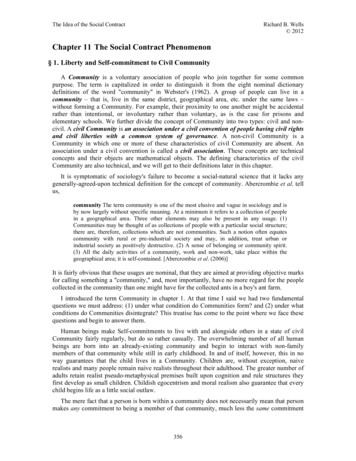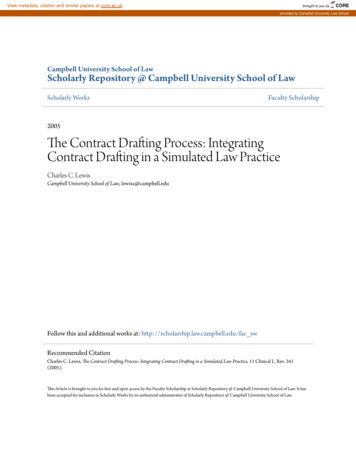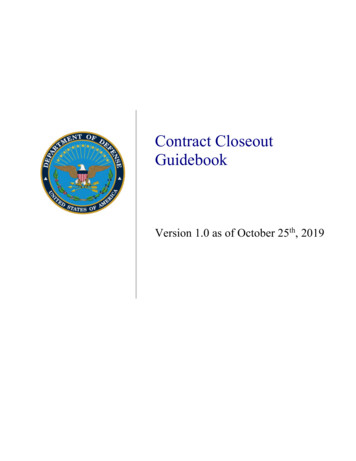
Transcription
The Idea of the Social ContractRichard B. Wells 2012Chapter 11 The Social Contract Phenomenon§ 1. Liberty and Self-commitment to Civil CommunityA Community is a voluntary association of people who join together for some commonpurpose. The term is capitalized in order to distinguish it from the eight nominal dictionarydefinitions of the word "community" in Webster's (1962). A group of people can live in acommunity – that is, live in the same district, geographical area, etc. under the same laws –without forming a Community. For example, their proximity to one another might be accidentalrather than intentional, or involuntary rather than voluntary, as is the case for prisons andelementary schools. We further divide the concept of Community into two types: civil and noncivil. A civil Community is an association under a civil convention of people having civil rightsand civil liberties with a common system of governance. A non-civil Community is aCommunity in which one or more of these characteristics of civil Community are absent. Anassociation under a civil convention is called a civil association. These concepts are technicalconcepts and their objects are mathematical objects. The defining characteristics of the civilCommunity are also technical, and we will get to their definitions later in this chapter.It is symptomatic of sociology's failure to become a social-natural science that it lacks anygenerally-agreed-upon technical definition for the concept of community. Abercrombie et al. tellus,community The term community is one of the most elusive and vague in sociology and isby now largely without specific meaning. At a minimum it refers to a collection of peoplein a geographical area. Three other elements may also be present in any usage. (1)Communities may be thought of as collections of people with a particular social structure;there are, therefore, collections which are not communities. Such a notion often equatescommunity with rural or pre-industrial society and may, in addition, treat urban orindustrial society as positively destructive. (2) A sense of belonging or community spirit.(3) All the daily activities of a community, work and non-work, take place within thegeographical area; it is self-contained. [Abercrombie et al. (2006)]It is fairly obvious that these usages are nominal, that they are aimed at providing objective marksfor calling something a "community," and, most importantly, have no more regard for the peoplecollected in the community than one might have for the collected ants in a boy's ant farm.I introduced the term Community in chapter 1. At that time I said we had two fundamentalquestions we must address: (1) under what condition do Communities form? and (2) under whatconditions do Communities disintegrate? This treatise has come to the point where we face thesequestions and begin to answer them.Human beings make Self-commitments to live with and alongside others in a state of civilCommunity fairly regularly, but do so rather casually. The overwhelming number of all humanbeings are born into an already-existing community and begin to interact with non-familymembers of that community while still in early childhood. In and of itself, however, this in noway guarantees that the child lives in a Community. Children are, without exception, naiverealists and many people remain naive realists throughout their adulthood. The greater number ofadults retain realist pseudo-metaphysical premises built upon cognition and rule structures theyfirst develop as small children. Childish egocentrism and moral realism also guarantee that everychild begins life as a little social outlaw.The mere fact that a person is born within a community does not necessarily mean that personmakes any commitment to being a member of that community, much less the same commitment356
Chapter 11: The Social Contract PhenomenonRichard B. Wells 2012other people might make. In different countries there are divers social institutions alreadyestablished that to some greater or lesser degree attempt to teach children that there are socialcommitments that come hand in hand with membership in their society. Churches and schools arethe two primary examples, and in some cases family units play an active role in this as well.But children develop their concrete and most fundamental maxims of what it means "to live ina society" from social intercourse with other children. This is because a child's first opportunitiesto participate as an equal in social intercourse are presented by experiences with other childrennear his or her same age. One result of this should be fairly obvious. The child gains his firstconcrete knowledge of concepts out of which will later come his ideas of society through hisexperience of associating with other little outlaws. If you take the time, spend the cost, make theeffort and exert the discipline to properly observe them, you will discover that the children inyour town or neighborhood form little subcultures all their own with their own sets of folkwaysand rituals that are carried out quite independently of the adult culture in which their lives areembedded. One can truthfully say they live in Kid World, a land where adults may not trespass.For example, it is well known that grade-school-age little boys fight each other from time totime. Take a very close look (without interfering and, most importantly, without being observedby them). What you will very likely find is that there is some quite specific ritual involved in it.For example, there might be a period of ritual name-calling and a great deal of posturing thatoccurs first, followed by, e.g., some preliminary shoving or wrestling before the first punch getsthrown. You'll likely find that any boy violating the ritual in the slightest way loses esteem in theeyes of his fellows, is made to suffer a period of disgrace, or is temporarily made an outcast.Although his theory suffers from some ontological defects, Piaget was not far off the markwhen he reported,And this is why, alongside of the primitive respect felt by the inferior for the superior, or,as we have called it, "unilateral respect," we have claimed to distinguish a "mutual" respecttowards which the individual tends when he enters into relation with his equals, or whenhis superiors become his equals. The quasi physical element of fear which plays a part inunilateral respect then gradually begins to disappear in favor of the purely moral fear offalling in the esteem of the respected person. The need to be respected thus balances that ofrespecting, and the reciprocity resulting from this new relation is sufficient to abolish allelement of constraint. At the same time, the commands vanish and turn into mutual agreement, and rules that have been freely consented to lose their character of externalobligation. Nor is this all. For since the rule is now subjected to the laws of reciprocity, it isthese same rules, rational in their essence, that will become the true norms of morality.Henceforward reason will be free to lay down its plan of action in so far as it remainsrational, that is to say, in so far as its inner and outer coherence is safeguarded, i.e., in sofar as the individual can adopt a perspective such that other perspectives will accord with it.Thus out of anomy and heteronomy, autonomy emerges victorious. [Piaget (1932), pp. 382383]As I brought up earlier, Piaget's notions of "respect" suffer from some serious ontological defects.His observational data, however, do clearly bring out the role that children's free association withother children plays in the child's development out of egocentric rule practice to the followingcooperative stage of rule practice. One interesting social phenomenon that appears to be worldwide in extent is the more or less thorough degree to which adults fail to understand or evennotice the formative impact that life in Kid World has on the socialization of their children. Thispoint came more or less to the forefront of social debate in mid- and late-1960s America when theso-called "generation gap problem" was a topic of popular discussion. Rather than seeking tounderstand the causes permeating the rebellion of young people against "the Man" (as youngpeople of that time tended to call authority figures), the greater majority of older Americans357
Chapter 11: The Social Contract PhenomenonRichard B. Wells 2012satisfied themselves by adopting the opinion that either "something was wrong with kids today"or that "something had gone wrong in the upbringing" of the baby-boom generation.The latter opinion, interestingly, has its corollaries with theories put forward by somepsychologists that assign primacy to the roles family and institutions (schools, churches) play inthe socialization of children. These theories tend to miss altogether, or to erroneously discount,the role that age-peer social interaction plays in the individual's formulation of his manifold ofrules and manifold of concepts1. This is not at all a strictly American phenomenon, as wasillustrated by a line that appeared in 1973 in Red Star, an old Soviet army newspaper:People are not born soldiers, they become soldiers. . . . And it should not begin at themoment when a new recruit is enlisted into the ranks, but rather much earlier, at the time ofthe first signs of maturity, during the time of adolescent dreams. [Red Star, 1973]By "the time of adolescent dreams," a young person has already formulated the greater part of thebedrock maxims of his social rules. That Soviet social theorists wholly missed their mark withtheir school-instituted social training practices, aimed at producing "the new Soviet man," istestified by the stunning speed of the collapse of the Soviet Union at the end of the 1980s. TheSpartan agoge and Nazi Germany's Hitler Youth were far more effective socializing systems.To discount the role childhood age-peer socialization plays in social compacting and socialcontracting phenomena later in adult life is in effect to discount and ignore human Nature and toneglect the motivational dynamic in the social atom. Over the past few years in the United Statesthere has been a growing amount of attention being paid to a new myth that speciously linksputative emotional and irresponsible behavior problems exhibited by teenagers with ungroundedspeculations promoted by new technologies in brain-imaging. This myth is nothing more than thelatest in a string of amateurish nonsense going back at least as far as the so-called "beatgeneration" of the 1950s, when playing bongo drums and rock 'n roll was more condemned thanbank robbery. One might think Americans cannot be happy unless they think something is wrongwith their children. Writing about that ignorant hysteria of the 1950s, humorist Bill Bryson said,Anyway, people had many other far worse things to worry about in the 1950s thannuclear annihilation. . . . Above all, they had to worry about teenagers. That's right. Teenagers became the number-one fear of American citizens in the 1950s.There had of course been obnoxious, partly grown human beings with bad complexionssince time immemorial, but as a social phenomenon teenagehood was a brand-new thing.(The word teenager had only been coined in 1941.) So when teens began to appear visiblyon the scene, rather like mutant creatures in one of the decade's many outstanding sciencefiction movies, grown-ups grew uneasy. Teenagers smoked and talked back and petted inthe backs of cars. They used disrespectful terms to their elders like "pops" and "daddy-o."They smirked. They drove in endless circuits around any convenient business district. Theyspent up to fourteen hours a day combing their hair. [Bryson (2006), pp. 126-127]1One example worthy of mention here because of its current and growing popularity among Americaneducators is provided by the theories of Soviet psychologist Lev Semyonovich Vygotsky. I'm sorry to saythat an ever-growing number of American educational theorists have fallen under the sway of the Vygotskymovement. The problem with Vygotsky's system is its thorough-going Hegelian premises that corruptalmost every aspect of the theory. That Vygotsky himself was a Hegelian is not surprising; the absurdlynon-scientific premises of Hegel (shorn of Hegel's direct references to God) was the foundational pseudophilosophy of Marxist-Leninist doctrine from its very beginning and permeated every aspect of socialcontrol and educational indoctrination in the old Soviet Union. The Vygotsky movement began in theUnited States in 1962 and has yet to run its course before it will eventually collapse, as it inevitably will,and become just one more exhibit in the museum of bankrupt, utterly unnatural education theories.358
Chapter 11: The Social Contract PhenomenonRichard B. Wells 2012The current myth is that "the teenager's brain is developmentally immature" and that this is thereason for teen mood and behavior problems. Scientifically, and as mental physics tells usunambiguously, this is utter hogwash and without a single patch of objectively-valid grounding.Arguing against the new mythology is psychologist and professor Robert Epstein:There is clear evidence that any unique features that may exist in the brains of teens – tothe limited extent such features exist – are the result of social influences rather than thecause of teen turmoil. . . . [A] careful look at relevant data shows that the teen brain weread about in the headlines – the immature brain that supposedly causes teen problems – isnothing more than a myth. . . .In 1991 anthropologist Alice Schlegel of the University of Arizona and Herbert Barry III,a psychologist at the University of Pittsburgh, reviewed research on teens in 186 preindustrial societies. Among the important conclusions they drew about these societies:about 60 percent had no word for "adolescence," teens spent almost all their time withadults, teens showed almost no signs of psychopathology, and antisocial behavior in youngmales was completely absent in more than half these cultures and extremely mild incultures where it did occur.Even more significant, a series of long-term studies set in motion in the 1980s . . .suggests that teen trouble begins to appear in other cultures soon after the introduction ofcertain Western influences, especially Western-style schooling, television programs andmovies. . . . Consistent with these modern observations, many historians note that throughmost of recorded human history the teen years were a relatively peaceful time of transitionto adulthood. Teens were not trying to break away from adults; rather they were learning tobecome adults. . . . My own recent research, viewed in combination with many otherstudies from anthropology, psychology, sociology, history and other disciplines, suggeststhe turmoil we see among teens in the U.S. is the result of what I call the "artificialextension of childhood" past the onset of puberty. Over the past half century, we haveincreasingly infantilized our young, treating older and older people as children while alsoisolating them from adults and passing laws to restrict their behavior. Surveys I haveconducted show that teens in the U.S. are subjected to more than 10 times as manyrestrictions as are mainstream adults, twice as many restrictions as active-duty U.S.Marines, and even twice as many restrictions as incarcerated felons. And research . . .shows a positive correlation between the extent to which teens are infantilized and theextent to which they display signs of psychopathology. [Epstein (2007)]If teenagers in Western Societies today are not spending very much of their time with olderadults, then who are they spending it with? The answer ought to be trivially obvious: with otherteenagers. If the leaders of a Society were to sit in council and decide, "Let us completely teardown our social order and becomes a country of outlaws," many Western countries – includingthe U.S. – could hardly go about doing it more effectively than they are right now2.Epstein's observations suggest, and mental physics states as a theorem, that there is preciselyone overriding factor at work in the natural-sociology of the phenomenon we have just discussed:curtailment and hindering of civil liberty. When a community imposes by force – whether by2In chapter 10, I alluded to the fact that high school students who visit me without their parents beingpresent behave quite differently from those whose parents are escorting them about. What is the preeminentdifference in behavior I see between these two cases? The young person who comes without his parentsbehaves precisely as one expects a mature (if inexperienced) adult would behave; the one who is in the towof his parents behaves precisely like the stereotyped "teenage child" is expected to behave. I have foundthat, provided I can avoid being stereotyped by the teen as a parent or an authority figure, when I treatyoung people sixteen years of age and up like adults, that is precisely how they behave. My lower cutofffigure of sixteen years is due solely to lack of data with under-sixteen-year-olds: I do not have enough firsthand data to draw empirical conclusions about the younger age group.359
Chapter 11: The Social Contract PhenomenonRichard B. Wells 2012means of a legal code or by means of social mores and folkways – the curtailment of civil libertyon a person who has already developed maxims and tenets that establish a Duty-to-himself torequire liberty, that community can expect to be repaid in kind with reciprocated antibondingrelationships.Human beings are, at every age, Self-determining beings. Despite the numerous metaphysicaldefects in his thesis, Hobbes was correct to say, "The right of nature is the liberty each man hasfor the preservation of his own nature. By liberty is understood the absence of externalimpediments which may often take away part of a man's power to do what he would, but cannothinder him from using the power left to him" [Hobbes (1651), pp. 79-80]. We might quibble thathe should have said "liberty of nature" rather than "right of nature" (because, strictly, the formeris correct and the latter is not), but his principal point is Critically true and of foundational importin the development of the individual human being's personal society and his personal moral code.Hobbes was vague concerning his concept of "a man's power to do what he would," but weunderstand this with Critical correctness when we understand it to mean the power of a person inits four headings of1.2.3.4.Quantity: the person's physical power, which subsists in the capacities of his body;Quality: the person's intellectual power, which subsists in his knowledge, intelligence, andjudgment;Relation: the person's tangible power, which subsists in his stock of material personalgoods, fungible skills, and his stock-of-time available to him for using them; andModality: the person's persuasive power, which subsists in his ability to sufficientlycommunicate his thoughts and ideas to other persons to thereby gain their consent,agreement or cooperation.At this point, I will state a theorem of fundamental importance to the Existenz of Communitiesand societies. Most of what remains of this treatise is spent discussing this theorem and itssignificance for human social-Nature. The theorem is this: A human being makes a reciprocalSelf-commitment to join in civil Community with others if and only if he judges that doing so isbeneficial to his personal liberty in exercising, maintaining, and improving the power of hisperson.§ 2. The Critical Significance of the Power of a PersonKant did not adequately develop the idea of the power of a person, but he did discuss thoselogically-essential marks that underpin its development. Why Kant himself did not go on fromthere to fully develop the thesis will likely remain a minor historical mystery. My own opinion isthat Kant's theocentric bias – which caused him to commit his error in developing a deontologicaltheory of Sitten (morals) and Moralität (morality) – caused him to overlook this Critical idea.Kant's theocentric bias does not so much show up in these logical marks as it does in the set ofobjectively non-valid precepts and maxims he drew from them, which Santayana quite correctlydenounced a little over a century later as, "the minimal tenets of the most abstract Protestantism"[Santayana (1905), pp. 96-97].One reason I hold this opinion is that Kant, uncharacteristically, committed a logical error insetting out these concepts. Rather than treating them by analysis, as the concept requires, in2LAR form, he presented them instead in one of his divisions-of-three forms. With Kant, thelatter form implies he is working to develop an idea of synthesis, which in turn implies he istrying to develop the idea as part of the transcendental Logic of human reasoning. That hefollowed this up with a list of very obviously Christian-centric maxims is a further clue to this.The result is a formal logic error belonging to the class Cicero criticized Epicurus for making:360
Chapter 11: The Social Contract PhenomenonRichard B. Wells 2012But how says our philosopher [Epicurus]? 'The desires are of three kinds, natural andnecessary, natural but not necessary, neither natural nor necessary.' To begin with, this is aclumsy division; it makes three classes when there are really only two. This is not dividingbut hacking in pieces. Thinkers trained in the science which Epicurus despised usually putit thus: 'The desires are of two kinds, natural and imaginary3; natural desires again fall intotwo subdivisions, necessary and not necessary.' It is a fault in division to reckon a speciesas a genus. [Cicero (45 B.C., a), II. ix. 26]The headings of the power of a person are divided between outer forms (Quantity andRelation) and inner matters (Quality and Modality). This properly reflects Kant's fundamentaldivision of the unity of duty (Verpflichtung) and obligation (Obligation) made in the theoreticalStandpoint of Critical metaphysics. This unity is called officium4. Kant wrote,All Duties are either right-Duties5 (officia juris6), that is, such that for which an outerlawgiving is possible, or virtue-Duties7 (officia virtutis s. ethica8) for which such [a lawgiving] is not possible; – virtue-Duties cannot be subject to outer lawgiving simply becausethey go to a purpose which (or the having of which) is also a Duty. [Kant (1797), 6: 239]In a civil Community, right-Duties are duties owed to defined civil rights held by each associate.In contrast and viewed deontologically, virtue-Duties are duties concerning civil liberties. TheCritical difference between civil rights and civil liberties is very important. No civil right is ever acivil liberty and no civil liberty is ever a civil right. These two terms can never be used assynonyms. Doing so leads to a great deal of trouble and conflict. I will discuss the distinctionbetween civil right and civil liberty in more detail later.If Kant had employed the self-discipline to subject his ideas to the same degree of piercinganalysis as he had previously employed in Critique of Pure Reason, it is possible that he mighthave avoided the error in formal logic I refer to above. Unfortunately, he seems to have beenabsorbed in his noble but nonetheless transcendent Ideal of some universal "humanity" in everyperson – which is to say, with his noble Ideal of a single universal moral code innate in everyperson. This seems to have led him to devote much more of his attention to matters of virtue-Dutythan to right-Duty. Consequently, when Die Metaphysik der Sitten was published he had alreadyaltered his treatment from analysis to precepts of synthesis. He wrote,Cultivation (cultura) of his natural powers (powers of intellect, powers of mind, powersof body) as a means to all possible ends is man's Duty to himself. Man is culpable tohimself (as a natural being) not to leave his natural gifts and capacity unused and rusting,as it were, of which his reason might someday make use . . .Powers of intellect9 are those whose exercise is possible only through reason. They arecreative so far as their use is not drawn from experience but rather derived a priori fromprinciples. Such things are mathematics, logic, and the metaphysics of nature, of which thelatter two are also included in philosophy, namely in the theoretical, which then does notmean wisdom, as the word itself would suggest, but only science, although the former canbe conducive to [science's] purpose.3inanes. Cicero uses the word in the connotation of being to no purpose, vain, futile, or unprofitable. Thusthis type of desire is one lacking in reality or real significance, hence "imaginary."4From the practical Standpoint, officium is the unity of Duty (Pflicht) and Obligation (Verbindlichkeit).Kant derived his officium terminology from Cicero's De Officiis.5Rechtspflichten6"laws of unities of duty (Verpflichtung) and obligation (Obligation)"7Tugendpflichten8bounden duties of virtue or ethics9Geisteskräft. Literally, "power of spirit."361
Chapter 11: The Social Contract PhenomenonRichard B. Wells 2012Powers of mind10 are those which stand at the disposal of the needs of understanding andthe rule it uses to satisfy its arbitrary aims, and because of this experience is their guide.They include memory, the power of imagination, and the like, on which can be builtlearning, taste (internal and external embellishment), and so forth, which furnishinstruments for a variety of intentions.Finally, cultivating the power of body11 (gymnastics, strictly) is looking after what makesthe equipment (the matter) in men, without which the purposes of men could not befulfilled; hence the continuing and deliberate invigoration of the animal side of man is Dutyof man to himself. [Kant (1797), 6: 444-445]The powers of mind he describes here align with Modality in the 2LAR division of the powerof a person. At first brush, it may not seem readily apparent that this has very much to do with thenotion of a person's persuasive power. However, how does one persuade another person? Kantdidn't say much about this, but Cicero, whose De Officiis Kant drew upon, did:As soon then as I have received my instructions and classed the case and taken the matterin hand, the very first thing I determine is that point to which I must devote all such part ofmy speech as belongs peculiarly to the issue and the verdict. Next I contemplate with theutmost care those other two essentials, the one involving the recommendation of myself ormy clients, the other designed to sway the feelings of the tribunal in the desired direction.Thus for purposes of persuasion the art of speaking relies wholly upon three things: theproof of our allegations, the winning of our hearers' favor, and the rousing of their feelingsto whatever impulse our case may require. For purposes of proof, however, the material atthe orator's disposal is twofold, one kind made up of the things which are not thought outby himself, but depend upon the circumstances and are dealt with by rule, for exampledocuments, oral evidence, informal agreements, examinations, statutes, decrees of theSenate, judicial precedents, magisterial orders, opinions of counsel, and whatever else isnot produced by the orator, but is supplied to him by the case itself or by the parties. Theother kind is founded entirely on the orator's reasoned argument. And so, with the formersort, he need only consider the handling of his proofs, but with the latter, the discovery ofthem as well. [Cicero (55 B.C.), II. xxvii. 114-117]Under my whole oratorical system and that very readiness in speaking which Crassus justnow lauded to the skies, lie three principles, as I said before: first the winning of men'sfavor, secondly their enlightenment, thirdly their excitement. Of these three the first callsfor gentleness of style, the second for acuteness, the third for energy. For, of necessity, thearbitrator who is to decide in our favor must either lean to our side by natural inclination, orbe won over by arguments for the defense, or constrained by stirring his feelings. [ibid., II.xxix. 128-129]Kant's powers-of-mind described above do not go immediately to a person's mental capacities,such as judgment and imagination, but instead to the application of their products "which furnishinstruments for a variety of intentions." This is what Cicero is describing to us in the quote above.The aims of the application are Modal: problematic in the rousing of feelings, assertoric in proofs,and apodictic in "winning the hearers' favor." This last one is apodictic in the context that oncethe hearer has made his own Self-determination, his following actions are Self-necessitated. Thusare Kant's powers-of-mind aimed at Modality in the power of a person.Kant's powers-of-intellect are fairly evident, once one has the Organized Being model well inhand, and reflects the aphorism "knowledge is power." That this refers to Quality in the power ofa person is likewise more or less trivially clear. So, too, it is with Kant's powers-of-body and its1011Seelenkräft. Literally, "power of soul," but remember that Kant uses "soul" and "mind" synonymously.Leibeskräft. The word implies "physical might."362
Chapter 11: The Social Contract PhenomenonRichard B. Wells 2012relationship to Quantity in the power of a person. Quantity and Quality in a 2LAR divisionalways refer to composition, and it is fairly frequently found in Kant's metaphysics that notions ofcomposition are more readily grasped than are notions of nexus.But what about Relation? The person's tangible power would seem to be the odd-man-out inKant's tripartite division. This, however, is because Kant presented and treated the issue oftangible commercium between individuals as a separate discussion topic:All officia12, whether strict or broad Obligation, are – as said – either interna vel externa13as to the
agers became the number-one fear of American citizens in the 1950s. There had of course been obnoxious, partly grown human beings with bad complexions since time immemorial, but as a social phenomenon teenagehood was a brand-new thing. (The word teenager had only been coined in 1941.) So when teens began to appear visibly











